6 scholarly books by Association Vahatra
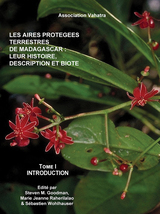
Les aires protégées terrestres de Madagascar
leur histoire, description et biota, tome 1: Introduction
Steven M. Goodman
Association Vahatra, 2020
In 1989, a book written by Martin E. Nicoll and Olivier Langrand was published on the protected areas of Madagascar, which heralded in a new era of conservation for this island nation. In the subsequent three decades, there was an important increase in inventories and studies on Madagascar’s terrestrial biota. This work led to significant changes in the systematics of Malagasy plants and animals, a large percentage unique to the island, and a notable augmentation in knowledge on Malagasy biodiversity. In addition, the considerable expansion of the protected area network, reinforcement of legal tools, and the development of new management modes and tools have contributed to a modernization of the protected area network.
The purpose of the French-language Les aires protégées terrestres de Madagascar is to present a large-scale update of information available from 98 terrestrial protected areas, various analyses to understand general trends in the conservation of these sites, and a synthesis to assess the needs for future scientific programs. Beautifully illustrated throughout with color maps, graphs, and photos, these three volumes will be an important reference for students, researchers, protected area managers, conservationists, and visiting ecotourists. Volume one provides a comprehensive introduction.
The purpose of the French-language Les aires protégées terrestres de Madagascar is to present a large-scale update of information available from 98 terrestrial protected areas, various analyses to understand general trends in the conservation of these sites, and a synthesis to assess the needs for future scientific programs. Beautifully illustrated throughout with color maps, graphs, and photos, these three volumes will be an important reference for students, researchers, protected area managers, conservationists, and visiting ecotourists. Volume one provides a comprehensive introduction.
[more]
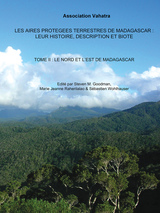
Les aires protégées terrestres de Madagascar
leur histoire, description et biota, tome 2: Le Nord et l'Est de Madagascar
Steven M. Goodman
Association Vahatra, 2020
In 1989, a book written by Martin E. Nicoll and Olivier Langrand was published on the protected areas of Madagascar, which heralded in a new era of conservation for this island nation. In the subsequent three decades, there was an important increase in inventories and studies on Madagascar’s terrestrial biota. This work led to significant changes in the systematics of Malagasy plants and animals, a large percentage unique to the island, and a notable augmentation in knowledge on Malagasy biodiversity. In addition, the considerable expansion of the protected area network, reinforcement of legal tools, and the development of new management modes and tools have contributed to a modernization of the protected area network.
The purpose of the French-language Les aires protégées terrestres de Madagascar is to present a large-scale update of information available from 98 terrestrial protected areas, various analyses to understand general trends in the conservation of these sites, and a synthesis to assess the needs for future scientific programs. Beautifully illustrated throughout with color maps, graphs, and photos, these three volumes will be an important reference for students, researchers, protected area managers, conservationists, and visiting ecotourists. Volume two covers northern and eastern Madagascar.
The purpose of the French-language Les aires protégées terrestres de Madagascar is to present a large-scale update of information available from 98 terrestrial protected areas, various analyses to understand general trends in the conservation of these sites, and a synthesis to assess the needs for future scientific programs. Beautifully illustrated throughout with color maps, graphs, and photos, these three volumes will be an important reference for students, researchers, protected area managers, conservationists, and visiting ecotourists. Volume two covers northern and eastern Madagascar.
[more]
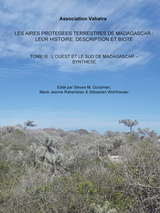
Les aires protégées terrestres de Madagascar
leur histoire, description et biota, tome 3: L'Ouest et le Sud de Madagascar - Synthèse
Steven M. Goodman
Association Vahatra, 2020
In 1989, a book written by Martin E. Nicoll and Olivier Langrand was published on the protected areas of Madagascar, which heralded in a new era of conservation for this island nation. In the subsequent three decades, there was an important increase in inventories and studies on Madagascar’s terrestrial biota. This work led to significant changes in the systematics of Malagasy plants and animals, a large percentage unique to the island, and a notable augmentation in knowledge on Malagasy biodiversity. In addition, the considerable expansion of the protected area network, reinforcement of legal tools, and the development of new management modes and tools have contributed to a modernization of the protected area network.
The purpose of the French-language Les aires protégées terrestres de Madagascar is to present a large-scale update of information available from 98 terrestrial protected areas, various analyses to understand general trends in the conservation of these sites, and a synthesis to assess the needs for future scientific programs. Beautifully illustrated throughout with color maps, graphs, and photos, these three volumes will be an important reference for students, researchers, protected area managers, conservationists, and visiting ecotourists. Volume three covers western and southwestern Madagascar, as well as provides a valuable synthesis.
The purpose of the French-language Les aires protégées terrestres de Madagascar is to present a large-scale update of information available from 98 terrestrial protected areas, various analyses to understand general trends in the conservation of these sites, and a synthesis to assess the needs for future scientific programs. Beautifully illustrated throughout with color maps, graphs, and photos, these three volumes will be an important reference for students, researchers, protected area managers, conservationists, and visiting ecotourists. Volume three covers western and southwestern Madagascar, as well as provides a valuable synthesis.
[more]
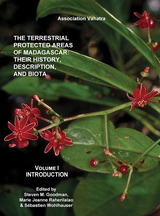
The Terrestrial Protected Areas of Madagascar
Their History, Description, and Biota
Steven M. Goodman
Association Vahatra, 2018
In 1989, a book written by Martin E. Nicoll and Olivier Langrand was published on the protected areas of Madagascar, which heralded in a new era of conservation for this island nation. In the subsequent three decades, there was an important increase in inventories and studies on Madagascar’s terrestrial biota. This work led to significant changes in the systematics of Malagasy plants and animals, a large percentage unique to the island, and a notable augmentation in knowledge on Malagasy biodiversity. In addition, the considerable expansion of the protected area network, reinforcement of legal tools, and the development of new management modes and tools have contributed to a modernization of the protected area network.
The purpose of The Terrestrial Protected Areas of Madagascar is to present a large-scale update of information available from 98 terrestrial protected areas, various analyses to understand general trends in the conservation of these sites, and a synthesis to assess the needs for future scientific programs. Beautifully illustrated throughout with color maps, graphs, and photos, these three volumes will be an important reference for students, researchers, protected area managers, conservationists, and visiting ecotourists. Volume one provides a comprehensive introduction.
The purpose of The Terrestrial Protected Areas of Madagascar is to present a large-scale update of information available from 98 terrestrial protected areas, various analyses to understand general trends in the conservation of these sites, and a synthesis to assess the needs for future scientific programs. Beautifully illustrated throughout with color maps, graphs, and photos, these three volumes will be an important reference for students, researchers, protected area managers, conservationists, and visiting ecotourists. Volume one provides a comprehensive introduction.
[more]
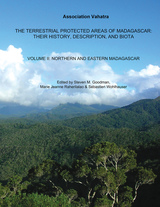
The Terrestrial Protected Areas of Madagascar
Their History, Description, and Biota, Volume 2: Northern and eastern Madagascar
Steven M. Goodman
Association Vahatra, 2020
In 1989, a book written by Martin E. Nicoll and Olivier Langrand was published on the protected areas of Madagascar, which heralded in a new era of conservation for this island nation. In the subsequent three decades, there was an important increase in inventories and studies on Madagascar’s terrestrial biota. This work led to significant changes in the systematics of Malagasy plants and animals, a large percentage unique to the island, and a notable augmentation in knowledge on Malagasy biodiversity. In addition, the considerable expansion of the protected area network, reinforcement of legal tools, and the development of new management modes and tools have contributed to a modernization of the protected area network.
The purpose of The Terrestrial Protected Areas of Madagascar is to present a large-scale update of information available from 98 terrestrial protected areas, various analyses to understand general trends in the conservation of these sites, and a synthesis to assess the needs for future scientific programs. Beautifully illustrated throughout with color maps, graphs, and photos, these three volumes will be an important reference for students, researchers, protected area managers, conservationists, and visiting ecotourists. Volume two covers northern and eastern Madagascar.
The purpose of The Terrestrial Protected Areas of Madagascar is to present a large-scale update of information available from 98 terrestrial protected areas, various analyses to understand general trends in the conservation of these sites, and a synthesis to assess the needs for future scientific programs. Beautifully illustrated throughout with color maps, graphs, and photos, these three volumes will be an important reference for students, researchers, protected area managers, conservationists, and visiting ecotourists. Volume two covers northern and eastern Madagascar.
[more]
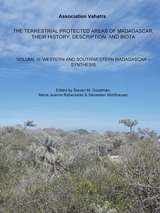
The Terrestrial Protected Areas of Madagascar
Their History, Description, and Biota, Volume 3: Western and southwestern Madagascar - Synthesis
Steven M. Goodman
Association Vahatra, 2020
In 1989, a book written by Martin E. Nicoll and Olivier Langrand was published on the protected areas of Madagascar, which heralded in a new era of conservation for this island nation. In the subsequent three decades, there was an important increase in inventories and studies on Madagascar’s terrestrial biota. This work led to significant changes in the systematics of Malagasy plants and animals, a large percentage unique to the island, and a notable augmentation in knowledge on Malagasy biodiversity. In addition, the considerable expansion of the protected area network, reinforcement of legal tools, and the development of new management modes and tools have contributed to a modernization of the protected area network.
The purpose of The Terrestrial Protected Areas of Madagascar is to present a large-scale update of information available from 98 terrestrial protected areas, various analyses to understand general trends in the conservation of these sites, and a synthesis to assess the needs for future scientific programs. Beautifully illustrated throughout with color maps, graphs, and photos, these three volumes will be an important reference for students, researchers, protected area managers, conservationists, and visiting ecotourists. Volume three covers western and southwestern Madagascar, as well as provides a valuable synthesis.
The purpose of The Terrestrial Protected Areas of Madagascar is to present a large-scale update of information available from 98 terrestrial protected areas, various analyses to understand general trends in the conservation of these sites, and a synthesis to assess the needs for future scientific programs. Beautifully illustrated throughout with color maps, graphs, and photos, these three volumes will be an important reference for students, researchers, protected area managers, conservationists, and visiting ecotourists. Volume three covers western and southwestern Madagascar, as well as provides a valuable synthesis.
[more]
READERS
Browse our collection.
PUBLISHERS
See BiblioVault's publisher services.
STUDENT SERVICES
Files for college accessibility offices.
UChicago Accessibility Resources
home | accessibility | search | about | contact us
BiblioVault ® 2001 - 2024
The University of Chicago Press









